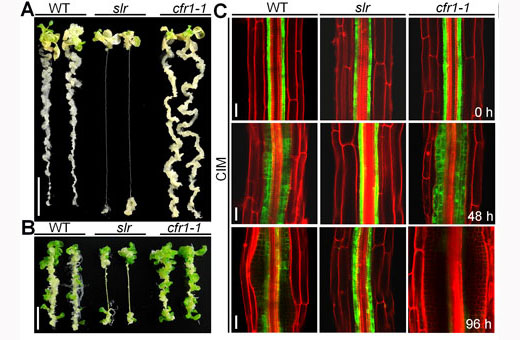PNAS:中科院植物所胡玉欣研究组发表植物细胞命运和再生能力控
2016年4月18日,国际著名学术期刊《美国国家科学院院刊》杂志在线发表了中国科学院植物研究所胡玉欣研究组的最新研究成果,文章报道了植物细胞命运和再生能力控制方面取得新进展。胡玉欣研究组博士生尚保栓及副研究员徐重益为本文的共同第一作者。
植物的组织和器官具有很强的再生能力,即已分化的细胞在离体和活体条件能够获得再生能力,再生出新的器官乃至完整个体。这种再生能力不仅是植物发育可塑性的根本,也是现代植物生物技术的基础。迄今为止,人们对于究竟植物细胞如何获得再生能力等问题仍知之甚少。
胡玉欣研究组的最新研究发现,超长链脂肪酸是限制植物中柱鞘类细胞获得全能性和再生能力的重要信号分子。在超长链脂肪酸合成存在缺陷时,拟南芥中柱鞘细胞形成愈伤组织的能力明显增强,而施加超长链脂肪酸则能够抑制中柱鞘细胞脱分化形成愈伤组织。进一步的研究表明超长链脂肪酸或其衍生物可能作为细胞层特异的信号物质,通过抑制细胞分生能力重要调控因子ALF4的表达而抑制中柱鞘类细胞形成愈伤组织,从而调控了植物器官的再生能力。
该研究首次揭示了超长链脂肪酸或其衍生物能够作为信号分子参与细胞命运及再生过程的调控,也对了解正常发育条件下动、植物体细胞命运的调控有重要启示,同时也对提升种质扩繁、转基因等技术有指导意义。

图:超长链脂肪酸限制拟南芥中柱鞘细胞全能性及其再生能力(A)超长链脂肪酸合成缺陷突变体cfr1能够恢复slr突变体的愈伤组织形成能力。(B)cfr1突变体根部所形成愈伤组织的不定芽再生能力增强。(C)愈伤诱导过程中中柱鞘细胞特异分子标记J0121的表达状况。
原文链接:
Very-long-chain fatty acids restrict reGENEration capacity by confining pericycle competence for callus formation in Arabidopsis
原文摘要:
The already differentiated organs in plants have a remarkable capacity to regenerate new individuals under culture conditions. Plant in vitro regeneration practically starts with the induction of a pluripotent cell mass, the callus, from detached organs on auxin-rich callus-inducing medium (CIM), which is generally required for subsequent regeneration of new bodies. Recent studies show that CIM-induced callus formation occurs from the pericycle or pericycle-like cells through a root developmental pathway, whereas the signals involved in governing callus-forming capacity of pericycle cells remain unknown. Here we report that very-long-chain fatty acids (VLCFAs) play a critical role in confining the pericycle competence for callus formation and thus the regeneration capacity of Arabidopsis. By genetic screening, we identified the callus formation-related 1(cfr1) mutant, which bypasses the inhibition of callus-forming capacity in roots by solitary-root (slr/iaa14). We show that CFR1 encodes 3-ketoacyl-CoA synthase 1 (KCS1), which catalyzes a rate-limiting step of VLCFA biosynthesis. Our biochemical and genetic analyses demonstrate that VLCFAs restrict the pericycle competence for callus formation, at least in part, by regulating the transcription of Aberrant Lateral Root Formation 4 (ALF4). Moreover, we provide evidence that VLCFAs act as cell layer signals to mediate the pericycle competence for callus formation. Taken together, our results identify VLCFAs or their derivatives as the confining signals for mediating the pericycle competence for callus formation and thus the regeneration capacity of plant organs.
作者:胡玉欣

